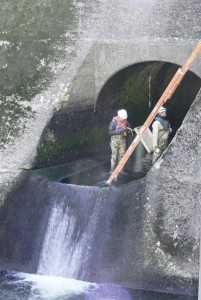By Michael Howell

Repairs to the outlet tunnel of the dam at Painted Rocks Reservoir were completed last week. Concerns about a potential fish kill led officials to institute a staged drawdown to give the fish time to relocate from the areas just below the dam that would dry up while repairs were made and a ‘fish rescue’ operation that would help save those that got stranded. Those efforts appeared to be largely successful, according to Montana Department of Fish, Wildlife and Parks fisheries biologist Chris Clancy.
The drawdown of water flowing through the outlet tunnel began on Tuesday when flows were reduced to about 30 cfs for about four hours to warn the fish that water levels were dropping. On Wednesday, following a little delay due to problems in getting the gates to close and seal, the flows were reduced to the point that repairs could be made to the walls of the tunnel.
According to DNRC official Brian Holling, it was too cold last spring, when repairs were first attempted, to get the concrete to set up properly in the short amount of time that the water was shut off. Leaving the water shut off too long could lead to fish mortality downstream. Following the drawdown last spring, some fish mortality was observed just downstream from the dam.
As a result, this time around officials used a special brand of concrete with a hot water mix that sets up faster and can set up in colder temperatures. The team was able to get in and out of the tunnel and make the repairs in the four-hour window of the drawdown. They patched a 40 inch by 30 inch L-shaped hole that was seven inches deep located about 100 feet inside the tunnel. The hole was seven inches deep into a 12 inch thick wall.
Meanwhile, outside the tunnel, FWP biologist Chris Clancy had set up three measuring gauges to monitor the change in flow depth downstream from the dam. He and volunteer helper Bill Jones raced between the gauging areas to take depth measurements as well as wetted perimeter measurements to more accurately determine the effects of the shutdown.
One thing they discovered, according to Clancy, is that the wetted perimeters held up pretty well during the four-hour shutdown. The width of the riverbed covered by enough water to keep a fish alive did shrink but remained on average about 60 percent covered during the drawdown.
“That’s a good thing as far as aquatic invertebrates go,” said Clancy. The loss of this “fish food” could have a negative effect on the fishery that would not be observed until much later, so he took this as a very good sign.
Clancy said that the gauge levels also gave them some valuable information. He said those readings indicated that water depth was dropping continually during the drawdown with no indication of slowing or leveling out. He said they had hoped to discover that the drop in water depth might show signs of decreasing or even leveling off, which would indicate that they might be able to lengthen the drawdown time and get more done. That does not seem like a viable option at this point.
There was good news to report from the small army of students and other volunteers who came to rescue stranded fish during the drawdown operation. Based on the results of two days’ work, according to Clancy, large trout seemed to fare very well through the episode.
“Large fish seemed to do quite well,” said Clancy. He said it was a little unclear about the fate of the smaller fish.”
Clancy said the volunteers moved a lot more fish on Tuesday than they did on Wednesday. He surmised that it might mean the staged drawdown strategy was working, although it’s not totally conclusive.
“They may have moved out of the area and not returned or they may have died and not been found,” he said. Large dead fish are more easily observed than small ones so it appears that the large fish managed well, but the impact on small fish like sculpin and juvenile trout are unclear. Only one dead juvenile trout (under 5 inches) and five dead sculpin were found on Wednesday.
Overall, no dead adult trout were found during the two days of dewatering. About 330 sculpin and 60 trout were found stranded and moved into pools.
Biology students from Brandon Honzel’s class at Big Sky High School in Missoula, Brett Shelagowski’s class and Alison Neils-LeMoine’s classroom without walls in Corvallis, and Tony Feist’s class from Stevensville, along with several volunteer anglers, participated in the fish rescue efforts.